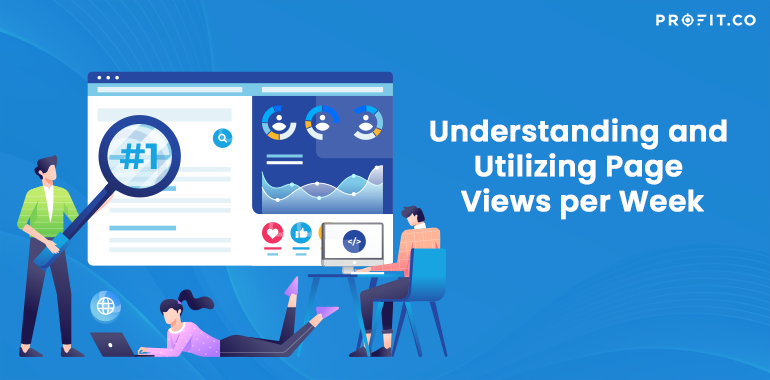Introduction
In the digital marketing world, understanding and analyzing Key Performance Indicators(KPIs)is crucial for measuring the success of your online strategies. One such vital KPI is ‘Page Views per Week’. This metric provides insights into the effectiveness of your content, website design, and marketing campaigns. Let’s dive into what it means, its formula, and how to interpret it through examples.
What are ‘Page Views per Week’?
‘Page Views per Week’ measures the total number of pages viewed on your website per week. Unlike unique page views, this metric counts every instance a page is loaded, offering a broader picture of user engagement and content popularity.
To efficiently measure website engagement, Google Analytics serves as a vital tool. It monitors your site’s page views, allowing you to track the number of views on different pages. This provides insights into the content that resonates most with your audience, highlighting what is engaging or appealing to them.
Understanding Pageviews, Sessions, and Users in Google Web Analytics
Web analytics offers a myriad of metrics to understand website performance, with Pageviews, Sessions, and Users being among the most critical. Here’s a detailed look at each and how they differ:
Pageviews
In Google Analytics, a Pageview is recorded every time a user views a page on your website. This includes multiple views of the same page by the same user. Pageviews give you an idea of how much your content is being consumed. High page views can indicate engaging content or a user-friendly layout. This metric is particularly useful for content-heavy sites like blogs or news websites, where the goal is to maximize content consumption.
Sessions
A session in Google Analytics starts when a user lands on your site and ends after 30 minutes of inactivity, or at midnight. It includes all the interactions a user has on your site within this period. Session helps you understand the context of user interactions. They show how users navigate through your site and the sequence of their activities. Sessions are key for e-commerce sites to track user journeys from landing to purchase, or for any site looking to understand user engagement over a single visit.
Users
Users are individuals who have visited your site. Google Analytics differentiates between ‘New Users’ (visiting for the first time) and ‘Returning Users’ (who have visited before). This metric helps in understanding your audience size and growth, as well as the effectiveness of your user acquisition strategies. Ideal for measuring the reach of marketing campaigns, and for understanding audience growth and loyalty.
“The future of advertising is in Internet”
Why is it Important?
Understanding ‘Page Views per Week’ helps gauge user engagement and interest in your website content. It reveals the effectiveness of marketing campaigns in driving traffic. This metric guides content strategy and website improvements. It’s crucial for optimizing digital marketing efforts and enhancing user experience.
- User Engagement: High page views suggest that your content is engaging and that visitors are keen on exploring your products or services. To further improve this, ensure your pages are easily readable by strategically using spacing, color, and font styles.
- Content Effectiveness: It helps gauge which content performs best, guiding content strategy. Optimizing your meta titles and descriptions is crucial for delivering content that aligns with user expectations.
- Marketing Campaign Impact: Spikes in page views can often be correlated with specific marketing efforts.
- SEO Optimization: Search engines may view pages with higher views as more relevant, potentially leading to better search engine rankings. Adapting to the growing trend of mobile searches by optimizing your content for mobile devices also improves ranking.
- Identifying User Behavior Trends: Analyzing page views over time can help you identify trends in user behavior. For example, if certain pages consistently have high views, they may show a sustained interest in specific topics or products.
Ready to start your KPI journey today?
Formula for Calculating Page Views per Week
This calculation involves simply adding up the total number of page views your website receives over a week. Each time a user loads a page on your website, it counts as one page view. The total sum of these views during a week gives you the ‘Page Views per Week’. This metric provides insight into the overall traffic and user engagement on your site within that time frame.
The formula is straightforward:
Page Views per Week = Total Number of Page Views in a Week
To get a more detailed analysis, you can segment this data by source, page type, or user demographics.
Examples
E-commerce Site
Imagine your e-commerce site had 10,000 page views per session last week. This week, after launching a new product line, your page views jumped to 15,000. This indicates a successful product launch.
Blog
Your tech blog averages 2,000 page views per week. After publishing a series of articles on a trending topic, your weekly page views rise to 3,500, suggesting high interest in this topic.
Corporate Website
A company’s website experiences a steady 5,000 page views per week. Following a major website redesign, the page views increase to 7,000, suggesting improved user experience or interest.
How to Improve Page Views per Week?
To improve ‘Page Views per Week,’ focus on creating engaging, high-quality content that resonates with your audience. Employ SEO best practices to enhance your website’s visibility on search engines. Leverage social media and email marketing to drive traffic to your site. Regularly update your website and use analytics to understand and cater to user preferences.
- Quality Content: Continuously update your website with engaging and relevant content.
- SEO Optimization: Implement SEO best practices to increase organic traffic.
- Social Media Promotion: Promote content on social media to drive traffic.
- Email Marketing: Use newsletters to bring users back to your site.
Measuring Page Views per Week KPI with OKRs
Measuring ‘Page Views per Week’ as a Key Performance Indicator (KPI) can be effectively done using Objectives and Key Results (OKRs). OKRs combine ambitious goals (Objectives) with specific, measurable actions (Key Results) to achieve those goals. Here’s how you can structure this
Objective: Significantly Increase Website Traffic and User Engagement
KR 1: Increase Page Views per Week from 5,000 to 8,000
Initiatives
- SEO Optimization: Implement a robust SEO strategy, including keyword optimization, meta tag enhancement, and improving the site’s overall SEO structure to increase organic traffic.
- Content Marketing: Develop and publish engaging, high-quality content regularly. Include blog posts, videos, infographics, and other forms of content that appeal to your target audience.
- Email Marketing Campaigns: Launch regular email newsletters featuring your latest content or updates, encouraging subscribers to visit your website more frequently.
KR 2: Boost Social Media-Driven Traffic from 1,000 to 2,000 Views per Week
Initiatives
- Targeted Social Media Advertising: Create and run social media ad campaigns targeting your audience demographics. Focus on platforms where your audience is most active.
- Interactive Social Media Content: Increase engagement on social media through interactive content like polls, Q&As, live sessions, and contests that encourage visits to your website.
- Collaboration with Influencers: Partner with social media influencers who can drive their followers to your website, thereby increasing social media-driven traffic.
KR 3: Improve Average Session Duration from 2 to 3 Minutes
Initiatives
- Website UX/UI Enhancement: Redesign your website to improve user experience and interface, making it more engaging and easier to navigate, which can encourage visitors to stay longer.
- Interactive and Rich Media Content: Incorporate interactive elements like quizzes, surveys, or embedded videos in your content, which can increase the time users spend on your pages.
- Content Depth and Internal Linking: Develop comprehensive, in-depth content and use strategic internal linking to guide visitors to related content, encouraging longer browsing sessions.
Conclusion
Monitoring ‘Page Views per Week’ is essential for understanding how visitors interact with your website. By analyzing trends and making data-driven decisions, you can optimize your online presence, improve user engagement, and ultimately drive business growth.
Remember, while ‘Page Views per Week’ is a significant KPI, it should be considered alongside other metrics to get a comprehensive view of your digital marketing success.

